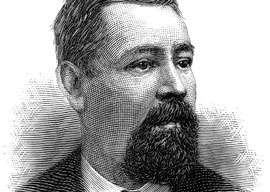
May 04, 2014

Justo Rufino Barrios
Like a man in a casino who fears he’s become a gambler, I had to leave the shop, or else I should have bought everything”or everything bizarre, which was the greater part of the stock. One day, however, I shall probably return to buy the Equatorial Guinean banknote with a picture of MacÃas Nguema on it. By the time I visited that country MacÃas had been overthrown and executed by his nephew, Thomas Obiang Nguema (president from 1979), and the MacÃas currency, the ekwele (plural bipkwele) had been replaced by the CFA franc. MacÃas forbade all printed matter, killed those who wore spectacles as dangerous intellectuals and threats to his regime, as well as about a quarter of the rest of the population, and was so solicitous of his country’s economy that he kept the national treasury under his bed. I think he is worth remembering.
I have had fun and instruction from banknotes in my time. I remember, for example, when I changed $50 in Bolivia and had to return to my hotel for a container in which to carry away all the pesos (paying for a meal by counting out cash took some time). South American inflation was excellent business for Thomas de la Rue and Company, who in those days printed most Latin American banknotes. (Real tyrants prefer that banknote printers not affix their names to notes, for to do so suggests a lack of self-sufficiency in the tyrants” domains, a kind of lèse-tyrannie.) Paraguayan banknotes portrayed only dictators, including the totalitarian Dr José Gaspar RodrÃguez de Francia, the immensely fat Carlos Anonio López, who so loved his country that he owned half of it, and Francisco Solano López, who led his country in the most disastrous war of modern times, in which 95 per cent of the male population perished. He is considered a hero in Paraguay. Among the other lessons I learnt from banknotes is that, in modern times, only communist countries count in threes. Thus I have a Cuban three peso note (with the ghastly Che Guevara on it) and an Albenian three lek note. This in turn demonstrates that the spread of communism was also the spread of Russian cultural influence, for while the Soviet Union printed 3 Ruble notes, this was a continuation of Tsarist practice.
A history of the modern world in banknotes, if it has not been written, would be instructive and, I think, alarming.